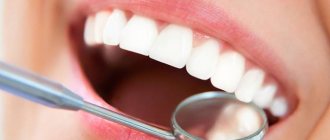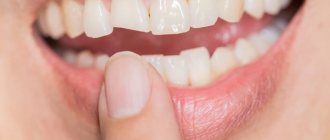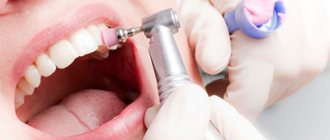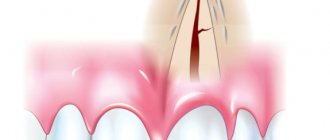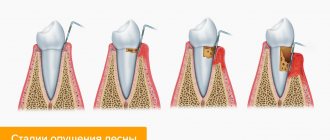Ideal teeth size
In dentistry, teeth of a certain size and anatomical shape are considered normal, depending on the size of the jaw and their location in it. They must be smooth, fit tightly to each other and have a thickness within certain limits: for example, the height of the lateral incisors in an adult is normally 7 - 11 millimeters. Of course, this does not mean that they need to be measured with a ruler - overall aesthetics and proportionality are much more important (for example, for people of short stature and fragile build, a small teeth size is appropriate). Many parents are interested in why their child has small teeth, but usually there is no reason to worry: normally, the baby incisors are small and located at a distance from each other.
However, if the patient really has very small teeth, you should definitely consult a dentist to confirm or exclude the diagnosis of microdentia.
How to tell if your teeth are really big
The size of human dental crowns has its own physiological limits. More often than others, the upper cutting elements, which are located in the center, seem excessively large. These two teeth in a mature person range from 9 to 13 mm in length. It usually depends on height. On each side of them, 2 teeth are usually shorter by a couple of millimeters. The ratio between the dimensions of the tooth crown in width and height is also important. Its ideal value is 1.25%. Long front teeth are counted when this number becomes smaller.
This condition has its own name – macrodentia. It is diagnosed only when a person’s teeth are one and a half times larger than the standard size.
With a normal crown size, from under the lip you can see the edge of the upper teeth, not exceeding 3 mm. Large front teeth in a child or teenager are quite normal. Gradually, the enamel wears down and the size of large crowns decreases.
Diagnosis of microdentia
According to statistics, about 5% of people face the problem of microdentia – abnormally small teeth in an adult. There are several signs that allow you to distinguish microdentia from other dental pathologies.
Symptoms of microdentia
- teeth of regular shape, but with a significantly reduced crown;
- distances between teeth visible to the naked eye;
- damage mainly to the front teeth;
- wavy or jagged shape of the cutting part of the affected tooth.
In most cases, the presence of microdentia can be determined by visual examination of the patient, but for a more accurate diagnosis, hardware diagnostics are performed. For example, the doctor can measure the overall width of the incisors of both jaws using a special instrument, as well as resort to x-rays. A deviation is considered to be a reduction of teeth by 1.5 mm or more relative to the norm. Based on the results of the examination, one of three types of microdentia is determined.
Isolated
If the patient has one or two small teeth, then we are talking about isolated microdentia. Most often, the front incisors (mainly the lateral incisors) are underdeveloped.
Relative
Relative microdentia is said to occur when the patient has an abnormally enlarged jaw. On such a jaw, even normal-sized crowns can look disproportionately small. Thus, relative microdentia is an overly large gum and small teeth on it.
Generalized
In the most severe cases, when small teeth are located throughout the jaw, the patient is diagnosed with “generalized microdentia.”
Orthodontic treatment
Braces
- a truly unique invention that can help with very, very many problems. In most cases, they really help with different lengths of the front teeth - especially if the incisors look shorter than the other due to an incorrect position in the mouth: for example, one is strongly tilted back or forward, or has grown slightly behind or in front of the other.
This treatment will be long-term, but the most effective of all other methods of straightening teeth of unequal length. In a certain way, tightened braces are quite capable of both “pulling out” a tooth that sits too deeply in the gums and “sinking” an excessively protruding one.
In any case, the need for treatment with braces and a suitable brace system will be determined by the dentist at the appointment. Even if the defect is too large and cannot be completely corrected with braces, orthodontic treatment
will significantly reduce visual unevenness, and in addition will help to avoid a number of other problems with malocclusion.
Reasons why teeth become small
As a rule, most of the reasons leading to the appearance of small front teeth in adults come from childhood, when pathological processes interfere with the formation of body systems. Microdentia can be a consequence of:
- severe infections suffered before the age of 2 years;
- exposure to radiation;
- inflammatory diseases in the mother during pregnancy;
- early removal of baby teeth;
- underdevelopment of the alveolar ridge and, as a consequence, lack of sufficient support for “growing” teeth of normal size.
Anomalies in tooth shape: causes
- heredity and genetic predisposition,
- disruption of the endocrine system, hormonal changes,
- serious diseases of the immune or endocrine system, taking certain potent medications during the formation of tooth buds,
- fusion of several tooth roots, resulting in a large tooth growing,
- incorrect position of the tooth, as a result of which it appears visually larger,
- initially incorrect growth of wisdom teeth, because permanent teeth “repeat” the movement of their predecessors,
- syphilis in children,
- difficult growth of wisdom teeth, which prevents the correct growth of the remaining teeth in the row.
Dangerous consequences of microdentia
At first glance, it seems that small teeth in an adult cause only aesthetic inconvenience, but this is not so. Dentists identify several quite serious problems that microdentia can lead to.
- Distal displacement of teeth,
that is, their gradual shift back relative to the optimal position in the jaw. - The appearance of gaps between the teeth
(the so-called diastemas and threes), which lead to disruption of the contact of the lateral surfaces of the teeth. Without support, the ligaments in the dental bed stretch and the tooth becomes unstable. - Diction disorders,
excessive amplification of hissing and whistling sounds in speech. - Periodontal disease
is a disease of the soft tissues of the jaw, caused by accumulations of bacteria in the interdental spaces and an enlarged periodontal pocket due to the high mobility of the tooth.
How does the process of changing teeth go?
The process of formation of the facial bones of the skull. Notice how the facial bones of the skull grow and become larger
.
As we develop, our jaws gradually grow, making room for permanent teeth. Children have a small skull, but a lot of teeth. And everyone must slide along complex trajectories in time towards the oral cavity, triggering the resorption of their milk predecessor. Root resorption is the process of dissolution of the roots of primary teeth under the constant pressure of the developing permanent teeth.
Lower fourth milk tooth. The roots are still there, as you can see, since it was removed before.
Due to the fact that we all at one time spat out baby teeth without roots, many have the erroneous understanding that baby teeth, in principle, do not have them. And the indigenous ones are already permanent. In fact, they have normal roots, only they are usually spread out to the sides to make room for a permanent bud. Often, as a result, parents think that they are almost being deceived when it comes to cleaning and filling the canals of baby teeth. “What channels? These are baby teeth, there aren’t even roots!” We have to show x-rays.
If we look at the orthopantomogram, we will see that the permanent teeth initially do not have a formed root. These are the so-called “cap” and “bell” phases. That is, when a tooth has just erupted, it does not have a thin exit from the root canal, but a huge wide hole. The process of final root formation will be completed only a few years after eruption. This is a wild problem for a dentist if the tooth requires depulpation and work in the canals. Normal endodontics is almost impossible.
How to fix small teeth?
Small tooth: what to do if it causes inconvenience, reduces self-esteem and worsens quality of life? Depending on the severity of the picture, the dentist may suggest the following correction methods:
- In case of isolated microdentia, small teeth can be corrected by installing veneers or lumineers - thin plates that are attached to the front surface of the tooth. This method is also suitable for eliminating threes and diastemas and increasing the width of the visible part of the crown. If your teeth grow unevenly, you will most likely need orthodontic correction using braces before placing veneers.
What to do if your two front teeth are large
Before and after photos show how the appearance of your smile and face changes after correction of large incisors. There are several methods that help give a large dental element the required shape. All of these can help make the tooth smaller.
- Contour type plastic surgery. This is a method in which the shape is given by grinding with a special grinding machine.
- Composite restoration (contouring and bonding). After grinding the dental crown, additional composite materials are used. This coating not only improves the shape of the teeth, but also protects the enamel layer.
- Application of veneers. Such onlays can be installed on adjacent teeth so that the front ones do not stand out so much. This is especially true if for some reason turning is impossible. Another option is to install lumineers. These are more elegant plates that do not require much grinding of the teeth, and in some situations the teeth for them do not need to be ground at all.
- There are situations when enlarged teeth are a consequence of a crooked bite. Classic braces help correct this problem. This method is recommended most often in adolescence from 11 to 18 years.
- Implantation. It is used in particularly difficult cases when it is necessary to remove a large tooth. Subsequently, the removed elements are replaced with implants.
Before choosing the appropriate option for a particular case, the dentist will offer to undergo an examination, including an examination and x-ray of the jaws. Experts often recommend leaving dental crowns in their original form, but if it is decided to correct the defect, then it will be necessary to increase hygienic care. Use fluoridated toothpastes, dental floss and even an irrigator. Because the enamel layer will become more at risk of carious destruction.

